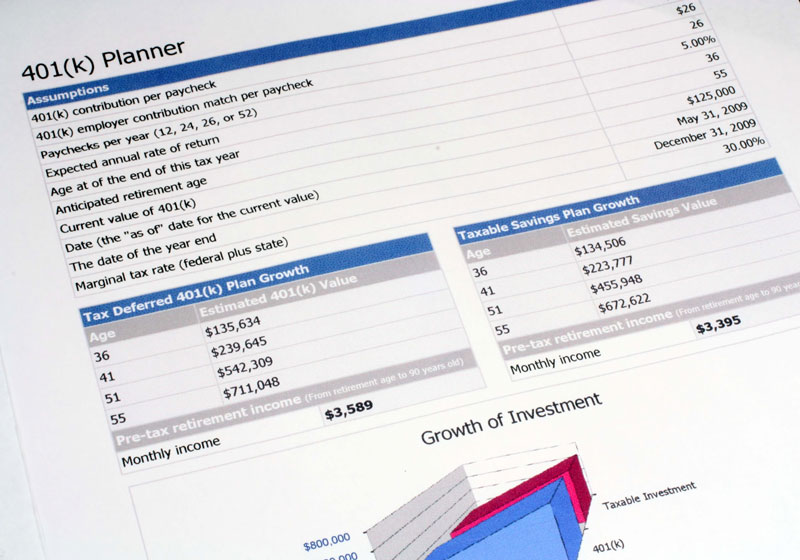
by Joseph P. Trybula, CFP®, AIF
Printers 401k
Employers face a daunting challenge: attracting and retaining the right talent necessary to drive their businesses forward. At the same time, they likely feel a responsibility to help employees reach retirement financially prepared. A 401(k) plan can help manage both of these goals.
Keeping an eye on the latest trends and tactics in the 401(k) arena is one way that employers can offer a competitive plan. Below is insight across a wide variety of companies and industries on contributions, investments, fees and fiduciary responsibilities that can help in evaluating individual companies’ plans.
Contributions
How many employees are contributing?
- In 2017, 79.3% of participants made contributions to their plans, up from 78.5% in the prior year. If their plan participation rate is less than overall or similar industry benchmarks, then companies should review their plan design options and develop a strategy to increase participation. If your plan exceeds benchmarks, consider what features might drive even higher participation.
- 74% of organizations offer a matching contribution to participant accounts – with an average contribution/deferral rate among active participants of 7%. Plans that offer an employer contribution are more attractive to both prospective and existing employees, which helps recruiting and retention efforts. Matching Benchmarks: Based on first 6% of salary contributed:
- More than 100% match: 7.9%
- 100% match: 12.1%
- 51-99% match: 33.8%
- 50% match: 22.1%
- Less than 50% match: 17.5%
- 41% of plans now automatically enroll eligible employees. Automatic enrollment may be the most direct way to increase plan participation. It also may help extend participation among more junior employees that might otherwise fail to enroll.
- Why is plan participation important? Each year, 401(k) plans must pass a series of compliance tests to ensure that the company owners and key personnel are not benefitting disproportionately compared to lower-paid employees. To pass these tests, plan metrics must fall within certain mathematical limits.
If a company happens to receive failing results, they may need to act quickly to take corrective action to maintain the tax-qualified status of their plan. These actions may include making taxable distributions to highly compensated employees (HCEs) or making additional employer contributions for other employees.
Investments
Just where is the money going?
- Plans offered an average of 22.8 investment options to participants, with participants holding an average of 5.7 investment options within their plans. This number has remained relatively steady over the past three years.
- 92% of plans offered mutual funds, and 71% of plans offered domestic equity index options.
Fees
What are participants actually paying in fees?
- 82% of plans annually review administrative costs and fees
- 63% calculated the actual fees the plan paid to its adviser
- 39% of companies have between 76 and 150 basis points as the average asset-weighted expense ratio of all investment options in the plan.
- The average plan is wasting 25 basis points of participants’ money per year and some are wasting in excess of 1%.
As a plan fiduciary, employers have a responsibility to ensure that the services provided to the plan are necessary and that the cost of those services is reasonable. To fulfill that important duty, employers need to make sure they understand the types of fees charged for their plan.
Fiduciary
- 37% of plans state their plan adviser is a fiduciary to their plan.
Selecting an investment professional to help with retirement plans is an important fiduciary matter – it’s crucial to understand the types of professionals available and how to choose the best one.
- 28% of plans did not have an investment committee.
No one likes to go it alone, especially when “it” is the oversight of an employer-sponsored retirement plan.
The fiduciary rules, regulations and the responsibilities to employees can be enormous burdens. Employers want to be in compliance, and they want to provide a plan that meets the goals and objectives set forth so employees can adequately prepare for the future.
Keep in mind the Employee Retirement Income Security Act’s (ERISA) original intent for retirement plans was for plans to be run by experts. Delegating administration and investment responsibility to outside experts insulates a plan sponsor from both liability and responsibility. The delegation of administrative and investment fiduciary duties to fiduciaries that accept them in writing can offer real value and peace of mind for plan sponsors.
The Printers 401k® Success by Design Program is a collaboration of 401(k) specialists who assume specific fiduciary duties for plans. The solution is designed to fulfill fiduciary obligations, allowing employers to continue serving as the plan sponsor without the liability and responsibility. Participants see reduced risk and work, lowered liability and plan cost, and improved plan operations and investments. Learn more at www.printers401k.com.

